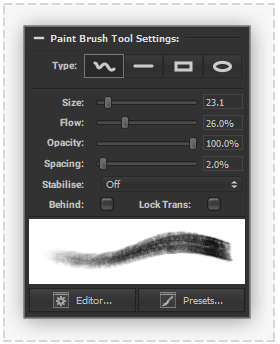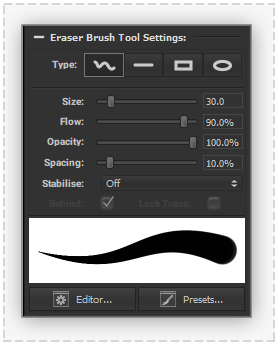Canvas Brush Tools: Difference between revisions
m (James moved page Canvas Tools Paint to Canvas Brush Tools) |
|
(No difference)
| |
Revision as of 16:52, 5 June 2020
This page is early work in progress draft. Information may be incorrect or incomplete.
 Paint Brush Tool
Paint Brush Tool
The paint brush tool provides an interactive tool to manipulate the pixel colours of areas of the current Canvas layer. Brush stamps of the current tool colour will be produced at regular intervals on the current Canvas Layer to produce the illusion of a brush stroke based on the following settings:
Type
Four brush types are provides that produce different results when using the cursor to interact with the canvas view.
- Freeform: Clicking and dragging the cursor in the canvas view will produce brush stamps under the cursor at regular intervals as it is moved.
- Line: Dragging the cursor between two points in the canvas view will produce a line comprising of brush stamps at regular intervals. A dashed line is provided during tool interaction to indicate where the output stamps will be produced. Holding the Shift key during tool interaction will snap the produced line to Horizontal or Vertical orientation.
- Rectangle: Dragging the cursor between two points in the canvas view will produce a rectangle comprising of brush stamps at regular intervals. A dashed line is provided during tool interaction to indicate where the output stamps will be produced. Holding the Shift key during tool interaction will snap the produced rectangle to be a square.
- Oval: Dragging the cursor between two points in the canvas view will produce an oval comprising of brush stamps at regular intervals. A dashed line is provided during tool interaction to indicate where the output stamps will be produced. Holding the Shift key during tool interaction will snap the produced rectangle to be a circle.
Flow
The flow level controls the transparency of each individual brush stamps. A flow level of 100% will provide a strong brush stroke, a lower flow level will provide a more natural fluid brush stroke.
Opacity
The opacity level controls transparency of the complete brush stroke. An opacity level lower than 100% provides maximum strength of the brush stroke, a lower opacity will not allow any element of a brush stoke to be above the specified opacity even if the same area is interacted with multiple times.
Radius
The radius control specifies the maximum radius of brush stamps in pixels. If a pressure sensitive input device is used and pressure sensitivity settings are active then the radius of brush stamps may be smaller than this specified radius.
Hardness
The hardness level controls the amount a brush stamp fades around it's edge. A hardness of 100% will mean no edge fading with happen. 0% hardness will produce a brush stamps opacity to fade from the completely way from centre to edge.
Spacing
The spacing level control specifies the spacing between brush stamps based on a brush stamps current radius. A level of 100% will cause no brush stamp overlapping, a low spacing level will cause brush to overlap more tightly.
Smoothing
When the freeform brush type is active this mode optional provides a smooth quadratic interpolation between the input cursors sample points.
Under normal operation this option is recommended to be active.
Stabilisation
Causes the removal of unstable movements in the brush stroke by limiting the maximum sample rate of cursor movement producing a smoother brush curves.
Pressure
If a pressure sensitive input device is being used such as a Wacom graphics tablet then these options allow the input pressure is dynamically affect the brush tool output. The following options are available:
- Disabled: Even if a pressure sensitive input device is available the pressure input will be ignored.
- Flow: The amount of pressure input is multiplies brush flow amount. The result is updated as each brush stamp is produced.
- Radius: The amount of pressure input is multiplies brush radius amount. The result is updated as each brush stamp is produced.
- Flow and Radius: Both the flow and radius amounts of the brush are both modified as specified above.
Behind
When active the paint brush output will be composited below the current layer pixel data.
 Eraser Brush Tool
Eraser Brush Tool
The eraser brush tool provides an interactive tool to manipulate the pixel transparency of areas of the current Canvas Layer.
Brush stamps of reduced opacity will be produced at regular intervals on the current Canvas Layer to produce the illusion of a brush stroke based on the following settings:
Type
Four brush types are provides that produce different results when using the cursor to interact with the canvas view.
- Freeform: Clicking and dragging the cursor in the canvas view will produce brush stamps under the cursor at regular intervals as it is moved.
- Line: Dragging the cursor between two points in the canvas view will produce a line comprising of brush stamps at regular intervals. A dashed line is provided during tool interaction to indicate where the output stamps will be produced. Holding the Shift key during tool interaction will snap the produced line to Horizontal or Vertical orientation.
- Rectangle: Dragging the cursor between two points in the canvas view will produce a rectangle comprising of brush stamps at regular intervals. A dashed line is provided during tool interaction to indicate where the output stamps will be produced. Holding the Shift key during tool interaction will snap the produced rectangle to be a square.
- Oval: Dragging the cursor between two points in the canvas view will produce an oval comprising of brush stamps at regular intervals. A dashed line is provided during tool interaction to indicate where the output stamps will be produced. Holding the Shift key during tool interaction will snap the produced rectangle to be a circle.
Flow
The flow level controls the transparency of each individual brush stamps. A flow level of 100% will provide a strong brush stroke, a lower flow level will provide a more natural fluid brush stroke.
Opacity
The opacity level controls transparency of the complete brush stroke. An opacity level lower than 100% provides maximum strength of the brush stroke, a lower opacity will not allow any element of a brush stoke to be above the specified opacity even if the same area is interacted with multiple times.
Radius
The radius control specifies the maximum radius of brush stamps in pixels. If a pressure sensitive input device is used and pressure sensitivity settings are active then the radius of brush stamps may be smaller than this specified radius.
Hardness
The hardness level controls the amount a brush stamp fades around it's edge. A hardness of 100% will mean no edge fading with happen. 0% hardness will produce a brush stamps opacity to fade from the completely way from centre to edge.
Spacing
The spacing level control specifies the spacing between brush stamps based on a brush stamps current radius. A level of 100% will cause no brush stamp overlapping, a low spacing level will cause brush to overlap more tightly.
Smoothing
When the freeform brush type is active this mode optional provides a smooth quadratic interpolation between the input cursors sample points.
Under normal operation this option is recommended to be active.
Stabilisation
Causes the removal of unstable movements in the brush stroke by limiting the maximum sample rate of cursor movement producing a smoother brush curves.
Pressure
If a pressure sensitive input device is being used such as a Wacom graphics tablet then these options allow the input pressure is dynamically affect the brush tool output. The following options are available:
- Disabled: Even if a pressure sensitive input device is available the pressure input will be ignored.
- Flow: The amount of pressure input is multiplies brush flow amount. The result is updated as each brush stamp is produced.
- Radius: The amount of pressure input is multiplies brush radius amount. The result is updated as each brush stamp is produced.
- Flow and Radius: Both the flow and radius amounts of the brush are both modified as specified above.

